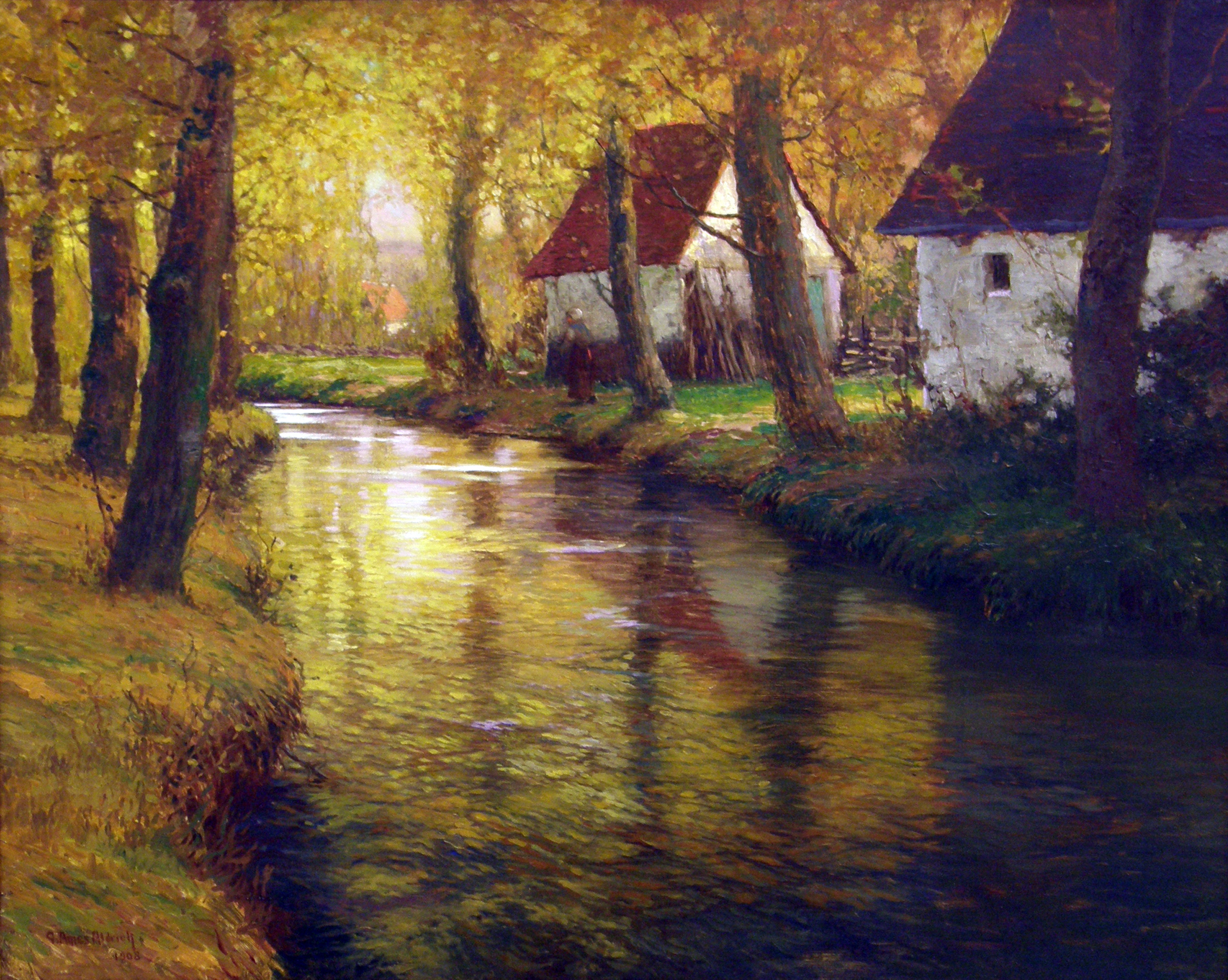- George Ames Aldrich: Art Commentary by Gregg Hertzlieb

George Ames Aldrich (1871-1941)
The River Elaune, Bellengreville, 1908
Oil on canvas
Gift of Phyllis (Buehner) Duesenberg (VU 1954, BA)
and Richard W. Duesenberg (VU 1951, BA, VU 1953, JD)
Brauer Museum of Art, 95.08
The River Elaune, Bellengreville is a lovely painting by the artist George Ames Aldrich, a beloved figure in South Bend where he lived for a number of years. An enigmatic figure who contributed to the mystery of his life by at times providing puzzling biographical information, Aldrich painted scenes of Chicago, South Bend, the east coast of the US, France, and various other locations in Europe. The Aldrich exhibition at the Brauer Museum of Art, curated by Michael Wright, is the first retrospective of the artist’s work and includes major pieces borrowed from many individuals and institutions.
Chicago-based independent art historian Wendy Greenhouse did much original research for the book related to the exhibition, published by Indiana University Press and available in early spring, 2013. Through her diligent efforts, she was able to unearth new information that connects Aldrich with teachers, contemporaries, and key exhibitions in Chicago, above and beyond those teachers that Aldrich cites as influential even though his actual or substantial contact with those figures is suspect. Through Greenhouse’s essays, Aldrich emerges as someone who created art that appeals both to the eye and heart, that comforts with a sentimental style of Impressionism applied to subjects often picturesque and familiar.
The exhibition came about through Michael Wright visiting the Brauer Museum and asking me about my interest in doing a major show of Aldrich’s work. The River Elaune, Bellengreville has long been a favorite of mine in our permanent collection, and I was enthusiastic about seeing more works by Aldrich. The fact too that so little biographical information existed about the artist led Wright and me to see value in accompanying the exhibition with a book reproducing all the pieces in the show and offering a scholarly examination of his life. Wright and I approached Greenhouse, one of the finest art historians working today, and she was able to shed much light on a figure obscure for far too many years. While Greenhouse engaged in her research, Wright located many excellent paintings to include in the show that represent a wide variety of subjects.
The Brauer’s Aldrich painting is a particularly fine example of a typical Aldrich painting. Wright, Greenhouse, and I realized early on that an Aldrich exhibition could easily consist of one painting after another that just showed a river or stream, with a house or cottage on the bank in the right half of the picture. Wright did an admirable job of selecting works showing landscapes of various types and from various vantage points, but he also wanted to have the classic Aldrich composition represented. Wright has commented many times on the quality of the Brauer’s picture, stressing that its portrayal of the artist’s favorite scene was especially pleasing in its effect.
The River Elaune, Bellengreville uses warm yellow and orange tones to draw us into the French scene, where nearly camouflaged by tones and textures a single figure walks beside the moving stream. Contrasts of light and dark, the overall amber cast, and the effect of isolation produced by the surrounding trees that open slightly to offer only a glimpse of a faraway horizon all work together to produce a feeling of immersion in a dark and private forest interior, where perhaps time slows and distractions fall away. Viewers find themselves in a private space, with the delicate sound of the moving water contributing to the peace. Aldrich shares a place where light enhances earthy tone and textures, where the land gives rise to small dwellings and their inhabitants who tend to this magical golden spot, a small pocket in the world that seems enchanted, graced as it is by the rich sunlight. The river flows toward viewers at the same time the river leads viewers into the picture, where by the time their eyes reach the single figure they realize that perhaps the figure could represent them, successful in their imagined efforts to locate themselves in this special place.
From time to time, I leave my desk and computer and go upstairs to see the delightful Aldrich pieces on display. I note that no matter the specific landscape, Aldrich is able to depict it as a place full of light and wonder, where I can escape for just a while and satisfy my need for pictorial beauty and comfort. I am grateful for the artist’s vision and am grateful too for the environment of the museum, where artistic creations can work their magic and transport us to realms where we are limited only by our imaginations.
Gregg Hertzlieb is Curator and Director of the Brauer Museum of Art at Valparaiso University. Hertzlieb is the editor of the books The Calumet Region: An American Place (Photographs by Gary Cialdella), published in 2009, and Domestic Vision: Twenty-Five Years of the Art of Joel Sheesley (2008), as well as a contributor to The Indiana Dunes Revealed: The Art of Frank V. Dudley (2006). He has been awarded the Edward L. Ryerson Traveling Fellowship by the School of the Art Institute in Chicago and a Conant Writing Award for Poetry from Millikin University. His artwork has been exhibited widely, including at the Aron Packer Gallery, August House Studio, the Central School of Art and Design in London, Columbia College, Elgin Community College, the Goodman Theater, and Struve Gallery.
